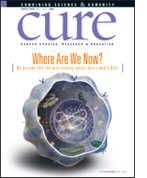Cell Restoration
Stem cell transplantation is safer and more accessible than ever before.
Stem cell transplantation has emerged as an important treatment for some types of cancer, specifically leukemia, lymphoma, and multiple myeloma. Although the technique faces many obstacles, cancer experts say the technology is steadily improving, allowing for more widespread use and better patient outcomes.
High doses of chemotherapy and radiation for treating cancer damage or destroy cells within the bone marrow called hematopoietic stem cells, which give rise to the three types of blood cells—red blood cells that carry oxygen throughout the body, white blood cells that fight infection, and blood-clotting platelets. Stem cell transplantation restores these cells.
In allogeneic transplantation, the cells come from a donor whose tissue type closely matches that of the patient. Autologous transplantation uses the patient’s own stem cells, which are extracted before cancer treatment and infused back into the patient after treatment.
Bone marrow is taken from the pelvic bone while the person is under anesthesia. However, the preferred method used today is stem cells, which can be collected from the bloodstream for all autologous and most allogeneic stem cell transplants.
Both the high-dose cancer treatment and stem cell transplant can have serious side effects. Cancer treatment can increase a person’s risk of infection, bleeding, and long-term complications such as infertility and damage to various organs.
People receiving allogeneic stem cell transplants may develop a serious condition called graft-versus-host disease (GVHD), in which white blood cells from the donor identify cells in the recipient’s body as foreign and attack them. Interestingly, this effect can also work against malignant cells, so mild GVHD is actually associated with less risk of recurrence.
Access to the procedure is also a barrier for some patients, including those who are too old to qualify and those in certain minority groups who cannot have transplants because no matching donors are available.
Recent innovations have improved the availability and outcome of stem cell transplantation, including better tissue matching between donor and patient to decrease the risk of GVHD. Researchers have found proteins called HLA antigens on the surface of cells, and the more HLA antigens on the donor’s cells that match those of the recipient’s stem cells, the less likely it is that the recipient will develop GVHD.
With better stem cell mobilizers, we can obtain stem cells in a higher proportion of people--and we can do it faster.
“When we started doing transplants, we needed matched siblings,” says Frederick Appelbaum, MD, director of the Division of Clinical Research at Fred Hutchinson Cancer Research Center in Seattle. “Now, we can carry out transplants using matched, unrelated donors and obtain results very close to those of matched siblings.”
A reduced-intensity transplant, or “mini-transplant,” in which patients are given lower, less toxic doses of chemotherapy and/or radiation, allows doctors to perform allogeneic stem cell transplants in more patients. The doses do not completely eliminate the patient’s bone marrow, but once the donor’s cells engraft, they are thought to destroy the cancer cells not destroyed by the chemotherapy and/or radiation.
“In people who, because of age or other diseases, are at increased risk for toxicity, the use of less toxic regimens has allowed us to administer transplants more safely,” says Edward Copelan, MD, director of the Program of Acute Leukemia at the Cleveland Clinic in Ohio, adding that doctors can now deliver the drug busulfan intravenously instead of orally, and can monitor blood levels of the drug and adjust dosage accordingly. “Both of these changes have decreased the toxicity of doing transplants,” Copelan says.
Blood from umbilical cords and placentas collected after childbirth are rich in stem cells and have greatly increased the supply of donor cells. Stem cells from cord blood require less stringent HLA matching, as mismatched cord blood cells are less likely to cause GVHD but retain their ability to kill cancer cells.
“The availability of cord blood makes an allogeneic transplant a possibility for the majority of patients who need it,” says Appelbaum.
Other improvements in stem cell transplantation include:
> Potent immunosuppressive drugs, such as cyclosporine and tacrolimus, have lowered the risk of GVHD.
> Stem cell mobilizers move stem cells from the bone marrow into the circulating blood where they can be collected for allogeneic or autologous transplantation. “Due to underlying disease, age, and past treatment, there are some patients in whom it is extremely difficult or impossible to obtain enough stem cells to do an autologous transplant. With better stem cell mobilizers, we can obtain stem cells in a higher proportion of people—and we can do it faster,” says Copelan.
> Agents have improved for fighting infections such as cytomegalovirus, a complication for people with a suppressed immune system. Doctors are now better able to monitor for the virus and treat it with an effective agent called ganciclovir. “What has improved cure rates over the past two decades has been better understanding and control of infections,” Appelbaum says. Treatments for fungal infections have also improved.
> Donor databases have broadened and include the National Marrow Donor Program (www.marrow.org) and Bone Marrow Donors Worldwide (www.bmdw.org).
Research into potential improvements in stem cell transplantation continues. "More than fifty thousand patients worldwide will have a stem cell transplant this year, and we have to continue to make it safer and better," Appellbaum says.
